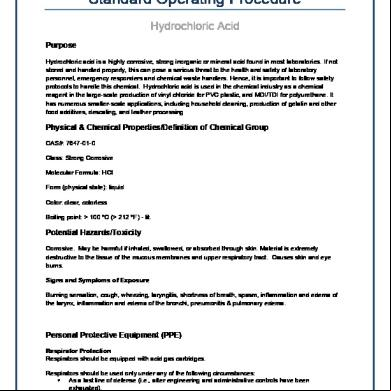Anhydrous Hydrochloric Acid : Production And Transportation 1d155c
This document was ed by and they confirmed that they have the permission to share it. If you are author or own the copyright of this book, please report to us by using this report form. Report l4457
Overview 6h3y3j
& View Anhydrous Hydrochloric Acid : Production And Transportation as PDF for free.
More details h6z72
- Words: 791
- Pages: 12
ANHYDROUS HYDROCHLORIC ACID: PRODUCTION AND TRANSPORTATION
PREPARED BY : GUIDED BY
PRUTHVISH MEHTA :
PROF. K.S. AGRAWAL
INTRODUCTION
• Hydrogen chloride (IUPAC NAME), chemical compound, HCl, a colorless, poisonous gas with an unpleasant, acrid odor. • Hydrogen chloride is a diatomic molecule, consisting of a hydrogen atom H and a chlorine atom Cl connected by a covalent single bond. • It is very soluble in water and readily soluble in alcohol and ether. • It fumes in moist air. • Because of its acidic nature, hydrogen chloride is corrosive, particularly in the presence of moisture • It is not flammable, and the liquid is a poor conductor of electricity.
http://www.encyclopedia.com/topic/Hydrogen_chloride.aspx
USES •
Manufacture of rubber.
•
Pharmaceuticals.
•
Inorganic and organic chemicals as well as in gasoline refining.
•
Metals processing.
•
Wool reclaiming.
•
Rubber hydrochloric films that a strong, water resistant and packaging material .
•
Manufacturing insert bearing blanks
•
In electronics industry, a high purity grade of hydrogen chloride is used as an etchant for semiconductor materials
Handbook of compressed gases, Compressed Gas Association, Springer Science & Business Media, 30-Jun-1999, page 417418
PROPERTIES
PYSICAL PROPERTIES
CHEMICAL PROPERTIES
• Molecular weight : 36.461 g/mol
• Latent heat of fusion (1,013 bar, at melting point) : 54.853 kJ/kg
• Melting point : -114.18 °C
• Latent heat of vaporization (1.013 bar at boiling point) : 448.87 kJ/kg
• Boiling point (1.013 bar) : -85 °C
• Critical temperature : 0.975 °C
• Liquid density (1.013 bar at boiling point) : 1192.98 kg/m3
• Critical pressure : 83.56 bar
• Gas density (1.013 bar at boiling point) : 2.1 kg/m3
• Critical density : 450.136 kg/m3
http://encyclopedia.airliquide.com/Encyclopedia.asp?GasID=17
PRODUCTION
•
LABORATORY METHODS:
•
Direct synthesis: Combination of hydrogen and chlorine in presence of UV light. Cl2(g) + H2(g) → 2 HCl(g).
•
Organic synthesis: Byproduct during formation of chlorinated and fluorinated organic compounds. e.g. Teflon, Freon and other CFCs R-H + Cl2 → R-Cl + HCl R-Cl + HF → R-F + HCl
https://en.wikipedia.org/wiki/Hydrogen_chloride
HCL GENERATOR
• Muriatic acid is dripped in a flask containing sulfuric acid . • Dehydration takes place absorbing water and liberating HCL gas. • HCl gas is the bubbled in sulphuric acid and stirred in IPA-Iso Propyl Alcohol
https://www.erowid.org/archive/rhodium/chemistry/hclgas.argox.html
METHODS OF SHIPMENT Under the appropriate regulation, anhydrous hydrogen chloride is authorized for shipment as follows:
Handbook of compressed gases, Compressed Gas Association, Springer Science & Business Media, 30-Jun-1999, page 417418
CONTAINERS AND CYLINDERS • Containers are manufactured to Department of Transportation (DOT) regulations, which specify the material of construction, method of manufacture, testing, and with what products they are permitted to be filled, as well as other details
• A cylinder is a hollow tube with a closed concave base and The opposite end is tapered to a small opening that is threaded to accommodate the installation of a valve. • Cylinders that meet the following TC/DOT are authorized for hydrogen chloride service : 3A1800, 3AA1800, 3AX1800, 3AAX1800 and 3E1800. • DOT-3A2015 and DOT-3T cylinders are often used in anhydrous hydrogen chloride services. Handbook of compressed gases, Compressed Gas Association, Springer Science & Business Media, 30-Jun-1999, page 418-419
CARGO TANKS AND TUBE TRAILORS • Constructed of SS, the tanks conform to DOT specification MC-331 or MC-338 and must be insulated.
• Handling large quantities tube trailors are used. • A typical tube trailer contains 21,000 pounds of hydrogen chloride.
Handbook of compressed gases, Compressed Gas Association, Springer Science & Business Media, 30-Jun-1999, page 418
VALVES AND CONNECTIONS
• The standard connection for hydrogen chloride is the CGA 330. •
An alternate approved connection for high-purity applications is the CGA 634. This is called a DISS (diameter index safety system) connection and requires a nickel gasket that seals with 35 foot pounds of torque. This connection has a right-hand thread (loosens counterclockwise). A new gasket should be installed each time a cylinder is connected.
http://www.airproducts.com/company/Sustainability/environment-healthandsafety/~/media/Files/PDF/company/safetygram-24.pdf
SAFETY AND HAZARDS •
A threshold limit value (TLV) ceiling limit of 5 ppm or 7 mg/m3 for hydrogen chloride has been adopted by the US Occupational Safety and Health istration and the American Conference of Governmental Industrial Hygienist
•
Inhalation of excess quantities of hydrogen chloride produces coughing, burning of the throat, and a chocking sensations.
•
Occasionally, ulceration of the nose, throat an larynx or edema of the lungs has resulted. Repeated exposure to skin may result in burns or dermatitis.
•
A concentration of 50 ppm in air cannot be tolerated for more than one hour and concentration of around 1500-2000 ppm are fatal for humans within a few minutes
•
Rubber or plastic aprons and gloves should be used as protective clothing with wool or other hydrochloric acid resistant outer garments and chemical goggles.
https://www.erowid.org/archive/rhodium/chemistry/hclgas.argox.html
THANK YOU
PREPARED BY : GUIDED BY
PRUTHVISH MEHTA :
PROF. K.S. AGRAWAL
INTRODUCTION
• Hydrogen chloride (IUPAC NAME), chemical compound, HCl, a colorless, poisonous gas with an unpleasant, acrid odor. • Hydrogen chloride is a diatomic molecule, consisting of a hydrogen atom H and a chlorine atom Cl connected by a covalent single bond. • It is very soluble in water and readily soluble in alcohol and ether. • It fumes in moist air. • Because of its acidic nature, hydrogen chloride is corrosive, particularly in the presence of moisture • It is not flammable, and the liquid is a poor conductor of electricity.
http://www.encyclopedia.com/topic/Hydrogen_chloride.aspx
USES •
Manufacture of rubber.
•
Pharmaceuticals.
•
Inorganic and organic chemicals as well as in gasoline refining.
•
Metals processing.
•
Wool reclaiming.
•
Rubber hydrochloric films that a strong, water resistant and packaging material .
•
Manufacturing insert bearing blanks
•
In electronics industry, a high purity grade of hydrogen chloride is used as an etchant for semiconductor materials
Handbook of compressed gases, Compressed Gas Association, Springer Science & Business Media, 30-Jun-1999, page 417418
PROPERTIES
PYSICAL PROPERTIES
CHEMICAL PROPERTIES
• Molecular weight : 36.461 g/mol
• Latent heat of fusion (1,013 bar, at melting point) : 54.853 kJ/kg
• Melting point : -114.18 °C
• Latent heat of vaporization (1.013 bar at boiling point) : 448.87 kJ/kg
• Boiling point (1.013 bar) : -85 °C
• Critical temperature : 0.975 °C
• Liquid density (1.013 bar at boiling point) : 1192.98 kg/m3
• Critical pressure : 83.56 bar
• Gas density (1.013 bar at boiling point) : 2.1 kg/m3
• Critical density : 450.136 kg/m3
http://encyclopedia.airliquide.com/Encyclopedia.asp?GasID=17
PRODUCTION
•
LABORATORY METHODS:
•
Direct synthesis: Combination of hydrogen and chlorine in presence of UV light. Cl2(g) + H2(g) → 2 HCl(g).
•
Organic synthesis: Byproduct during formation of chlorinated and fluorinated organic compounds. e.g. Teflon, Freon and other CFCs R-H + Cl2 → R-Cl + HCl R-Cl + HF → R-F + HCl
https://en.wikipedia.org/wiki/Hydrogen_chloride
HCL GENERATOR
• Muriatic acid is dripped in a flask containing sulfuric acid . • Dehydration takes place absorbing water and liberating HCL gas. • HCl gas is the bubbled in sulphuric acid and stirred in IPA-Iso Propyl Alcohol
https://www.erowid.org/archive/rhodium/chemistry/hclgas.argox.html
METHODS OF SHIPMENT Under the appropriate regulation, anhydrous hydrogen chloride is authorized for shipment as follows:
Handbook of compressed gases, Compressed Gas Association, Springer Science & Business Media, 30-Jun-1999, page 417418
CONTAINERS AND CYLINDERS • Containers are manufactured to Department of Transportation (DOT) regulations, which specify the material of construction, method of manufacture, testing, and with what products they are permitted to be filled, as well as other details
• A cylinder is a hollow tube with a closed concave base and The opposite end is tapered to a small opening that is threaded to accommodate the installation of a valve. • Cylinders that meet the following TC/DOT are authorized for hydrogen chloride service : 3A1800, 3AA1800, 3AX1800, 3AAX1800 and 3E1800. • DOT-3A2015 and DOT-3T cylinders are often used in anhydrous hydrogen chloride services. Handbook of compressed gases, Compressed Gas Association, Springer Science & Business Media, 30-Jun-1999, page 418-419
CARGO TANKS AND TUBE TRAILORS • Constructed of SS, the tanks conform to DOT specification MC-331 or MC-338 and must be insulated.
• Handling large quantities tube trailors are used. • A typical tube trailer contains 21,000 pounds of hydrogen chloride.
Handbook of compressed gases, Compressed Gas Association, Springer Science & Business Media, 30-Jun-1999, page 418
VALVES AND CONNECTIONS
• The standard connection for hydrogen chloride is the CGA 330. •
An alternate approved connection for high-purity applications is the CGA 634. This is called a DISS (diameter index safety system) connection and requires a nickel gasket that seals with 35 foot pounds of torque. This connection has a right-hand thread (loosens counterclockwise). A new gasket should be installed each time a cylinder is connected.
http://www.airproducts.com/company/Sustainability/environment-healthandsafety/~/media/Files/PDF/company/safetygram-24.pdf
SAFETY AND HAZARDS •
A threshold limit value (TLV) ceiling limit of 5 ppm or 7 mg/m3 for hydrogen chloride has been adopted by the US Occupational Safety and Health istration and the American Conference of Governmental Industrial Hygienist
•
Inhalation of excess quantities of hydrogen chloride produces coughing, burning of the throat, and a chocking sensations.
•
Occasionally, ulceration of the nose, throat an larynx or edema of the lungs has resulted. Repeated exposure to skin may result in burns or dermatitis.
•
A concentration of 50 ppm in air cannot be tolerated for more than one hour and concentration of around 1500-2000 ppm are fatal for humans within a few minutes
•
Rubber or plastic aprons and gloves should be used as protective clothing with wool or other hydrochloric acid resistant outer garments and chemical goggles.
https://www.erowid.org/archive/rhodium/chemistry/hclgas.argox.html
THANK YOU








